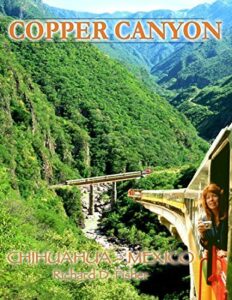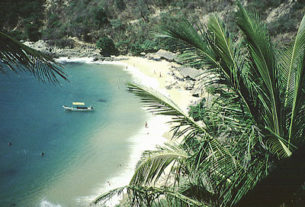I suspect this may turn out more like a travel article than a book review. In late March we took a tour through the length of the Copper Canyon and I find it difficult to know how to write about this book without bringing in various aspects of the Canyon trip itself.
It really is a spectacular journey and Richard Fisher’s account does total justice to the subject matter. This is a large format quality paperback and it contains hundreds of excellent photos of the people and places one encounters along the way. I can’t imagine a better souvenir to take away.

The train ride itself is probably the biggest feature. The rail line is usually – and rightly – described as one of the world’s finest engineering wonders. It takes you through the most rugged country imaginable, from Los Mochis to Chihuahua City, a distance of some 390 miles. In the process you travel through 86 tunnels and across 39 bridges. It climbs 8,000 feet from sea level to its highest point, near the town of Creel, which is named after one of the builders of the railroad. The views along the way are spectacular and there are lots of breathtaking moments when the passengers can look from their seats and see a drop of several hundred feet immediately below. It’s amazing that anyone could even conceive of building such a railroad let alone actually complete it so successfully.
Two trains travel the route every day. One heading north, the other going south. The total one way journey takes about 12 hours. However, one can make overnight stops. And there are some marvelous places to stay en route.
In the town of El Fuerte (The Fort) at the southern end of the ride, you’ll find one of the most beautiful hotels in Mexico – El Fuerte Lodge Hotel. The rooms, the courtyards and the gardens are an absolute delight to the eye with their arrangements of plants, paintings, masks, ornaments and various antiques. Also, the Hotel Divisadero Barrancas is another striking facility built on the extreme edge of the Canyon with every room offering a view, for miles and miles across the canyon and hundreds of feet straight down.
However, before I get too carried away I should mention that this book has one huge, for me, aggravating fault. The pages aren’t numbered and there’s no index. There’s a contents listing up front with about thirty different topic headings but to actually find anything you have to go searching page by page to find it. The topic headings cover an amazing range of subjects, from the Cave Dwellings of Huapoca Canyon and Tarahumara Culture to Backpacking the Barrancas and Soil Fertility and much much more.
Also, it’s not a terribly well organized book. There are some marvelous photos of the railroad but the actual story of the railroad and how it came to be built is in an entirely different section, nowhere near the photos.
But the basic stuff is all there – everything you want to know about the Copper Canyon. Just be prepared to do a lot of page turning. For instance, the book has a subtitle – The Puzzle of Oasis America. It must have taken me at least a half hour of searching to finally discover the meaning of that term.
“Oasis America” is how modern Mexican archeologists describe the desert oasis cultures in the southwestern U.S. and northern Mexico. The origins and disappearance of the Anasazi Indian culture in the American southwest has long been a mystery. It has always been a “puzzle” as to where these people came from and to where they mysteriously disappeared.
The entire topic is covered in a lengthy abstract here in The Copper Canyon.
There’s also a major section on the Tarahumara Indians who inhabit much of the canyon, many of them, it would seem, still dwelling in caves. Our tour group visited one such cave and got a glimpse of a way of life that, frankly, I just can’t imagine.
In one section of the book, author Kit Williams describes “The Art of Being Tarahumara” and writes about how nearly every adult Tarahumara is a craftsperson, producing pottery, basketry, blankets, carved figurines, embroidered sashes and blouses and so on. This is all very much in evidence when you go to the Divisidero area. I remember one woman sitting alone on the edge of the canyon with a display of her handiwork. It seemed that she actually climbed a wooden ladder to come up from the canyon every day and – if you can believe – clutching a baby to her breast!
This isn’t so much of an organized text as it’s a “grab bag” of information about its overall subject. It’s made up of random notes, photos, directions, maps, temperature and rainfall charts, schedules, descriptions of places, lists, archaeological texts, etc. etc. However, before I sound too negative and critical let me say that I found all the various pieces interesting- especially the photographs – but not too well organized.
If nothing else, I realize now that what I saw on my five days of touring in the Canyon was a mere pinprick compared to what is actually there to be discovered. But, who knows, maybe I’ll be lucky enough to find myself back there again someday.
In my humble O: If you are planning a trip to the Copper Canyon, by all means make sure you get a copy of this book. I got mine at one of the train stops en route, as did all the other people in our group. The young man who was selling them made quite a killing that morning.
Copper Canyon – Chihuahua, Mexico
By Richard D. Fisher
Sunracer Publications, 2003
Available from Amazon Books: Paperback

